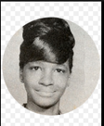University of Southern Mississippi History Project
The Desegregation of USM
By Michael Seth Spataro
In August, 1965 Elaine Armstrong and Raylawni Branch would make history in which they were responsible for the desegregation of University of Southern Mississippi. In a time where Jim Crow was at its peak in the South these two women left a permanent mark in not only our school history, but also Mississippi history. In this essay we are going to analyze the lives of Branch and Armstrong before joining USM, as well as a look into the day in which the administration learned about their admissions which tell us a lot about USM administration at the time.

Figure 1A Elaine Armstrong

Figure 1B Raylawni Branch
The main chunk of my information comes from the Oral History of Raylawni Branch which you can see her and Elaine pictured above. Raylawni Branch spent most her life being a Civil Rights Activist in the 1959-1965 in which she was a secretary in the NAACP, as well as members of of COFO (Council of Federated Organizations) and SNCC (Student Non- Violent Coordinating Committee) and SCLC (Southern Christian Leadership Conference).[1] In 1965, the NAACP came up to Raylawni Branch and asked her if she would attend USM with 18 year old high school graduate Elaine Armstrong. The reason the NAACP asked Branch to help ease the transition of being the first African Americans to integrate at USM is because of her past experiences in integration in which she states, “I had personally integrated - or what I called at
that time integrated - the Big Yank or Reliance Manufacturing.”[2] These were the reasons the NAACP asked for her assistance in this matter. Now I will say that the information that I gathered for Elaine Armstrong mostly comes from Branch Oral History, but as we speak they are collecting Oral History of Armstrong as well with no release time. The information I did gather from Branch Oral History is that the reason Elaine Armstrong attended USM was because she had to take care of her disabled mother, and because of that had to live close by.
The only protest that Branch mentions in her Oral History came in the form of the Klan which gathered a protest in the city of Petal. When Branch was describing this event, she was talking to Armstrong in which she makes fun of the situation stating, “We should make ourselves some sheets and go over there to see what they're going to say about us.”[3] What this shows is the experience of being a Civil Right Activist during the early part of her life and her giving the encouragement to Armstrong that these actions aren’t serious in fact they never came in contact with Klan while attending USM.
Now the main focus of this essay comes from Sidney Weatherford who finds out about Branch and Armstrong attending USM, and is organizing a panel to make sure nothing happens to them when they first come to school[4]. In the report, Sidney is in charge of the admissions office which means he is responsible for overseeing freshman admissions into USM. On July 25, 1965, Sidney was approached by an unknown FBI agent who informed him of Elaine Armstrong and Raylawni Branch admissions to attend USM. For Sidney, this came as a surprise and immediately went and brought this to the attention of then USM president William Mccain in which Sidney recounts Mccain feeling about the situation, “Needless to say, he was not happy. He appeared both disappointed and upset.”[5] What I think this shows is that the upper administration like Mccain did not want this to happen, but knew that there was nothing he could do to stop the integration from happening. In fact Mccain was so upset by the news that he eventually let Sidney coordinate the whole thing because he surely did not want to be a part of it according to Sidney. During that same day, Sidney gathered together multiple departments at USM which include, Director of Public Relations, Dean of Women, Assistant Dean of Men, and the President of Student Government. Now the reason Sidney is working so hard is because he does not want a similar thing that happened at the University of Mississippi to happen at USM. Now he doesn’t mention specifically what event, but with further research I assume he is referencing James Meredith when he integrated at Ole Miss which was met with riots protesting the integration. For Sidney, he personally did not want this to happen again, and in that meeting he designated roles for every member that joined the meeting which ensured that Branch and Armstrong did not run into any trouble during their time at USM.
What I found interesting about this event is that nothing came from it. There were no protest against the integration like in James Meredith's case and in fact it seemed like Branch and Armstrong were able to blend in with the student body. This is supported when I looked into the Student Printz of 1965-1966 to see if there was any mention of Branch or Armstrong in which there wasn’t supporting the notion that integration wasn’t the end of the world like Mccain probably thought it would. I imagine that students at USM during that time did not really care for the integration, and if they did they most likely kept it to themselves. Both the Oral History and the overview of Desegregation at USM provide a clear insight to what integration felt like and went through.
Citations
Raylawni Branch Online Oral History, 1993 https://usm.access.preservica.com/uncategorized/IO_6e0ea481-0396-4c8c-89ea-ec194d7d7185/
Sidney Weatherford, The Desegregation of USM, Mccain archives at USM, 2010
[1] Raylawni Branch, Oral History of Raylawni Branch, 3
[2] Raylawni Branch, Oral History of Raylawni Branch, 4
[3] Raylawni Branch, Oral History of Raylawni Branch, 5
[4] Sidney Weatherford, The Desegregation of The University of Southern Mississippi, 2
[5] Sidney Weatherford, The Desegregation of The University of Southern Mississippi, 3
